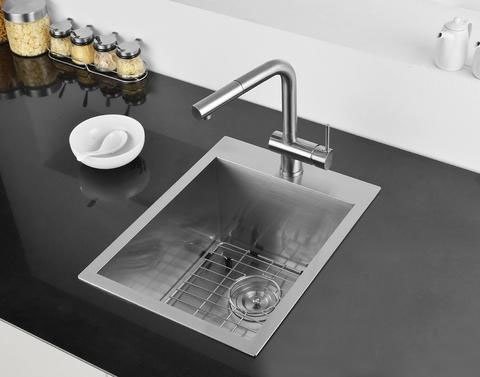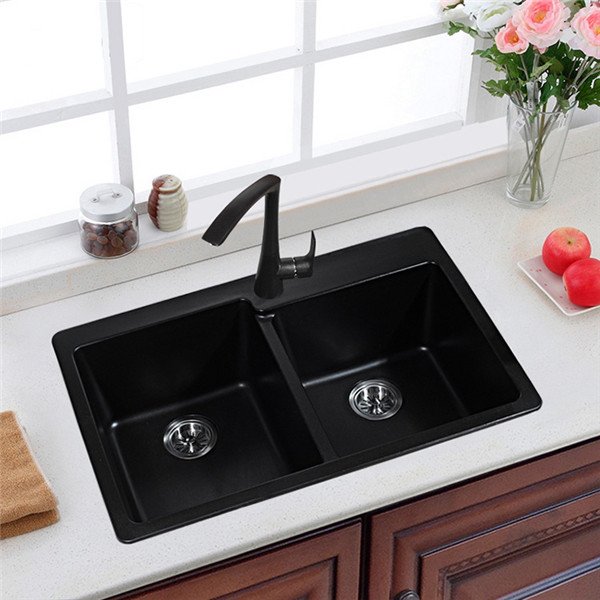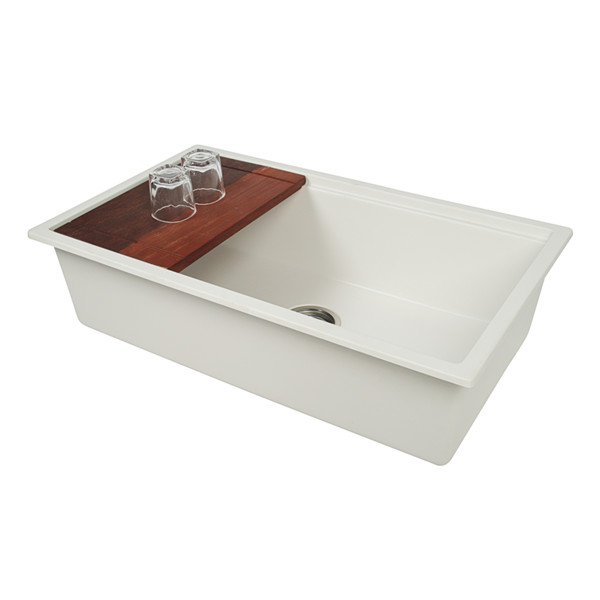Many people are looking for the perfect sink. Much of the time, they do not consider how big of a sink they will need. This is an issue because it can be frustrating to find a sink small or large that fits your kitchen. Unless you want to replace your countertops and cabinets, it is important to buy the right-sized sink. In order to make this process easier, we have created a guide to help you buy the right sized sink for your kitchen.
Types of Kitchen Sinks
There are three types of kitchen sinks: top-mount, undermount, and apron front. Each type of sink has advantages and disadvantages.
Top-Mount Sinks
Top-mount sinks are held in place by a lip that rests on the countertop. Because they are readily available in most home improvement and hardware stores, they tend to be more affordable than other types of sinks. They also come in a variety of materials and styles and can easily be installed by homeowners without any prior experience.
Although they are less expensive than many other types of sinks, top-mount sinks have some significant downsides. They are more difficult to clean than undermount or apron front sinks because food particles often get trapped between the sink and the countertop, creating an ideal breeding ground for bacteria. Additionally, because they sit on rather than under the countertop, they often look bulky and out of place on modern countertops.

Undermount Sinks
Undermount sinks are installed under the counter so that their rim is hidden from view, giving them a sleek, seamless appearance. They can be made from stainless steel or any number of other materials and come in different styles to suit any kitchen design aesthetic.
The Pros and Cons of Undermount and Drop-in Sinks
Sink design has come a long way from the porcelain enameled tubs of yesterday. Choosing the right sink for your kitchen can make or break your countertop. The sink should coordinate well with your countertop and backsplash, as well as fit in with the style of your cabinets. The two most popular styles of sinks are undermount and drop-in.
Undermount Sinks
An undermount sink is exactly what it sounds like — a sink that is mounted underneath the countertop. This type of installation results in a smooth transition between the sink and the countertop. These sinks are typically made of stainless steel or another type of solid surface material, such as composite granite or quartz.
The Pros
The main advantage to undermount sinks is their clean look. Because they don’t have a visible rim, they tend to lend an elegant look to any kitchen. Undermount sinks also make cleaning easier, since you can simply wipe crumbs and debris straight into the sink without having to maneuver around a rim. They also allow for more usable counter space because there is no lip to obstruct placement of items on the countertop in front of the sink.

The Pros and Cons of Double-Bowl Sinks
If you’re considering a double-bowl sink for your kitchen, you’ll want to weigh the pros and cons before taking the plunge. On the one hand, they offer twice as much sink space as their single-bowl counterparts, making it easier to wash larger items or tackle bigger cleanup jobs. On the other hand, there are some downsides that you may not have considered.
Advantages of Double-Bowl Sinks
The primary advantage of a double-bowl kitchen sink is its versatility. You can wash dishes in one side and rinse them in the other, or you can use each side for different tasks such as washing food and draining pasta. With a single-bowl sink, however, there’s only room for one task at a time — washing dishes in a large single bowl takes up all of your available space.
A double-bowl sink also allows you to divide up your work area into zones. For example, you might put dirty dishes on one side of the sink and clean dishes on the other side as they come out of the dishwasher; when both sides are full, it’s time to make room by putting away any clean dishes — an easy way to make sure that clean items don’t
The Pros and Cons of Porcelain Sinks
More than any other element of the design, it is the kitchen sink that gets the most attention in a kitchen. The sink is where you will do the most work, and while it is important to choose one that is easy to clean, it’s also important to choose one that fits with your design goals.

Pros
Porcelain sinks are a popular choice because they’re so versatile. They can be made in just about any color or shape, and they’re extremely durable. They can even be used as an accent material on countertops.
Cons
On the downside, though, porcelain sinks are hard to keep clean. They scratch and chip easily because the surface isn’t as smooth as other materials, but it does need to be cleaned regularly to avoid stains. If you have children in your home, this may not be an ideal choice for your sink.
Porcelain sinks come in a variety of colors and designs. You can get them with white enameled finishes that look like granite or marble. These are easy to clean and durable enough for everyday use. There are also stainless steel porcelain sinks that have a more polished look and don’t
The Pros and Cons of Stainless Steel Sinks
Stainless steel sinks are a great choice when it comes to kitchen sinks. They are durable and long-lasting, and they have a nice, classic look to them. But, like any material, stainless steel has its pros and cons. Here’s a brief rundown of some of the things you might want to consider before you buy your next sink.

Pros
Durable: Stainless steel is very resistant to damage from heat, cold and impact. It will last for years and is unlikely to get scratched or dinged up in normal use — though it can happen!
Easy to Clean: Because stainless steel is nonporous, it doesn’t collect dirt or grime and is easy to wipe down with soap and water. Just be sure not to use anything too abrasive on your sink because it will scratch the surface.
Stylish: Stainless steel comes in many different styles, from brushed metal that looks elegant in a modern kitchen to hammered metal that adds a rustic touch. You can also choose between sinks made with single or double basins which allow you more flexibility when you’re cleaning or preparing food.
Cons
Noisy: Stainless steel isn’t meant for soundproofing like some other materials are, so your sink’s basin may echo or vibrate.
The Pros and Cons of Granite Composite Sinks
Granite composite (compared to standard granite) offers many benefits, not the least of which is its ability to resist high and low temperature fluctuations, its natural resistance to scratching, staining and chipping, and its ability to be used in a variety of different colors – including matte finishes – – and to be used in a variety of different colors. -you’ll have a hard time getting rid of traditional granite alone.

At the same time, there are definitely some drawbacks to using granite composite sinks.
Pros
Durable
The durability of granite composites is absolutely outstanding.
You get a lot of the hardness, strength and stiffness of a traditional granite sink, combined with the forgiveness, slight ductility and “flexibility” of a composite material.
That means you get a gorgeous, hard sink that looks strong and durable without the worry that when you throw dishes into the sink for rinsing or cleaning, they’ll immediately break on contact.
Variety of Sizes, Styles, Shapes
When you work with natural granite materials, you have to work around whatever Mother Nature decided to make years ago – and you don’t exactly appreciate that when you choose to continue working with granite composites.
Because of the mix of granite and composites, there are more styles, more patterns, more shapes and more sizes to choose from when you choose to go in this direction. When you decide to go in this direction, you open up a world of kitchen design ideas.
Nonporous, Hygienic, and Resistant to Heat
Natural granite is very porous and must be sealed (and then resealed periodically) to work well as a gutter, and most homeowners are not interested in maintenance every six months or even every year.
With granite composite, however, you get a highly non-porous and almost hydrophobic material that drains like the back of a duck.
As a result, you’re talking about a more sanitary sink because there are no nooks or crannies for bacteria to hide in like a granite sink.
Cleaning is Easy (No Chemicals Needed)
Keeping your granite composite sink looking as good as new is pretty straightforward.
Some regular cleaning from time to time (probably every month or so) goes a long way toward keeping the finish looking great.
If what you’re cleaning is particularly acidic or has a high likelihood of staining, you may want to scrub harder that night – spaghetti night or any night when you had a little wine and went down the drain – but otherwise, you don’t have to use it as much as you would with traditional granite sinks to look after the granite composite.

Cons
Cheaper Sink Options Out There
For starters, while granite composite options are much less expensive than traditional granite options, they are not the “budget option” for today’s homeowners.
In terms of pricing, stainless steel sinks are still the absolute bottom of the market, while offering many of the same benefits (and possibly some additional benefits) that granite and granite composite sinks do not currently offer.
If you are making a new sink decision based on price alone, you will want to look elsewhere than granite composite.
Decent Risk of Chipping and Cracking
When you combine granite with a composite material, the risk of chipping and cracking is significantly reduced, but that doesn’t mean the risk is completely eliminated.
After all, you’re still dealing with 95% natural granite material that is at risk of damage – even if that material is protected by 5% resin or other composite materials that bind everything together.
You can pound a granite composite sink more than traditional granite because of the impregnation of the resin material, but you won’t necessarily be able to put heavy pots and pans into the sink without the same bad thing happening.
Pretty Big, Bulky, and Heavy
Stainless steel sinks are popular because they are easy to install, in large part because they are lightweight and can be handled comfortably with one hand.
This does not happen with granite composites.
This material is still big, still bulky, and definitely on the heavier side. You’ll need some help installing this new sink in your kitchen, but you’ll also need to consider strengthening the area around the sink (and maybe even underneath it) to make sure your granite composite choice is not stressed on your countertops or cabinets.
Require Special Upkeep
Special maintenance is required every year or so (or if anything particularly acidic or with a high potential for contamination gets into your sink, as we highlighted above) – even if it’s not as special as traditional granite would require.
Several companies have developed special non-chemical cleaners to help you quickly treat granite composites, which is a great way to keep everything neat (and sanitary) if you want to do so without damaging the finish or potentially damaging the resin in your sink.
However, you don’t have to go through the resealing process that you may have to go through with traditional granite options.
Even if a little special maintenance is required, this is a big plus because not too many people get excited about the idea of resealing granite sinks every 12 months to keep them looking great.
Higher Potential for Staining with Lighter Colors
Lighter colors in the granite composite world are more likely to stain than darker colors, for obvious reasons.

However, you may be more interested in the fact that light-colored granite composites can cause serious damage and even higher chances of staining than light-colored traditional granite sinks.
Much of this has to do with the resin used in light-colored composite sinks, which can absorb a lot of acidic or staining material into itself and then “hold” it almost permanently – the only way to get rid of it is to destroy the piece of resin and then refurbish the entire sink (or replace the entire sink itself).
If your house regularly eats pasta or drinks a lot of wine at night (some of which ends up in the sink), you’ll want to make sure you can clean things quickly and effectively, or you’ll risk staining the lighter granite composite.
A lot of this can be avoided by using darker colors. However, if you want that bright, brilliant white or other lighter shade because it makes a visual impact in your kitchen, more cleaning is required as a trade-off.
Final Thoughts…
There you have it – no pun intended on “everything but the kitchen sink”!
In this article, I describe the different styles of sinks available, the different sizes/configurations of sinks, and the different types of materials they are made of.
The kitchen sink may not be the most glamorous part of your kitchen, but that doesn’t mean it should be an afterthought. From corner to copper, single bowl to ceramic, there is a style that is perfect for adding je ne sais quoi to your new kitchen.



